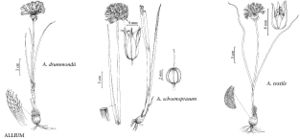Allium schoenoprasum
Sp. Pl. 1: 301. 1753.
Bulbs 1 or more, clustered, short-rhizomatous at base, cylindric, elongate, 0.5–0.9 × 1.5–2 cm; outer coats enclosing bulbs, grayish or brownish, persisting as fibrous reticulum but often appearing membranous as outer coats are lost during collecting, cells minutely striate; inner coats whitish or pinkish, cells closely parallel, elongate. Leaves persistent, green at anthesis, usually 2, distalmost usually ensheathing 1/3–1/2 scape; blade hollow, terete, fistulose, 20–60 cm × 2–7 mm. Scape persistent, 2–12+, clustered, erect, terete, fistulose, 20–50 cm × 3–5 mm. Umbel persistent, erect, compact, 30–50-flowered, ± subglobose, bulbils unknown; spathe bracts persistent, 2, 3–7-veined, lanceolate to broadly ovate, ± equal, apex short-acuminate. Flowers campanulate, 8–12 mm; tepals erect, pale purple to deep lilac, drying pink, particularly on midrib, or white, elliptic to lanceolate, ± equal, becoming papery in fruit, permanently investing capsule, margins entire, apex acute to acuminate, tips ± recurved, midribs not thickened; stamens included; anthers purple; pollen white; ovary crestless; style linear, equaling stamens; stigma capitate, unlobed or obscurely lobed; pedicel 2–6 mm. Seed coat shining; cells minutely roughened, not pustuliferous. 2n = 16.
Phenology: Flowering Jun–Aug.
Habitat: Wet meadows, rocky or gravelly stream banks and lake shores, circumboreal
Elevation: 0–3500 m
Distribution
Alta., B.C., Man., N.B., Nfld. and Labr., N.W.T., N.S., Nunavut, Ont., P.E.I., Que., Sask., Yukon, Alaska, Colo., Conn., Idaho, Maine, Mass., Mich., Minn., Mont., N.H., N.J., N.Y., Ohio, Oreg., Pa., R.I., Vt., Wash., Wis., Wyo., Siberia.
Discussion
Allium schoenoprasum is native in North America, but it is also cultivated and has widely escaped. It is an extremely polymorphic species, and throughout its range both large and small races occur. These plants have been known as A. sibiricum, A. schoenoprasum var. sibiricum, or A. schoenoprasum var. laurentianum, and many, largely unsuccessful, attempts have been made to distinguish the varieties. Until the variation can be worked out along natural lines, if any, instead of unstable features such as plant size, and color and shape of the tepals, recognition of these varieties is unsound. Because we are unable to separate native populations from many of the escaped ones, we cannot reliably map the native distribution of this taxon in the flora.
